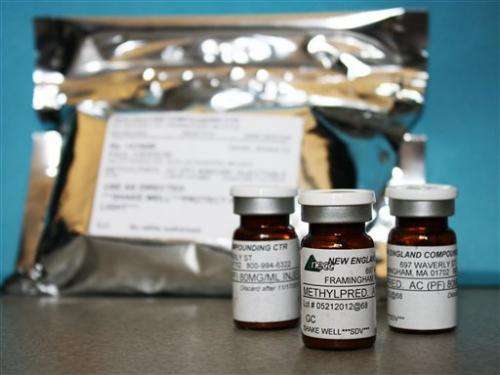US : Fungus in tainted steroids and patients match (Update 2)

(AP)—The fungus found in tainted steroid shots matches the one blamed in the national meningitis outbreak that has killed 20 people, federal health officials said Thursday.
The match confirms the link between the outbreak and the maker of the steroids, New England Compounding Center of Framingham, Massachusetts. Officials previously said they found fungus in more than 50 unopened vials from the company, but needed more tests to determine the kind of fungus.
The specialty pharmacy has been at the center of a federal and state investigation into more than 250 fungal meningitis cases. The death toll rose Thursday to 20.
The victims in the outbreak had all received steroid shots made by the pharmacy, mostly to treat back pain. The company last month recalled three lots of the steroid made since May. It later shut down operations and recalled all the medicines it makes.
The fungus was found in one steroid batch made in August, according to the Food and Drug Administration and the Centers for Disease Control and Prevention. CDC has said all the illnesses so far had been tied to one lot.
The initial recall involved about 17,700 single-dose vials of the steroid sent to clinics in 23 states. As many as 14,000 people got shots from the three lots. The FDA and CDC said Thursday that tests were continuing on the other two batches.
A spokesman for the pharmacy said a statement was being prepared.
The fungus in the vials—Exserohilum rostratum— is the same as that found in at least 40 people sickened with fungal meningitis, said the CDC's Mary Brandt, whose lab did the testing.
"We were able to link the organism in these vials to the organism in the patients," she said.
The FDA-CDC announcement did not say how many tested vials had that kind of fungus.
Exserohilum is common in dirt and grasses, but it rarely causes illness and has never before been identified as a cause of meningitis, CDC officials have said.
Meningitis is caused by the inflammation of meninges, which are protective membranes covering the brain and spinal cord. Tainted spinal injections would directly put germs into that part of the body.
Also on Thursday, the CDC said New York has reported a fungal illness, making it the 16th state with outbreak cases. The others are Florida, Idaho, Illinois, Indiana, Maryland, Michigan, Minnesota, New Hampshire, New Jersey, North Carolina, Ohio, Pennsylvania, Tennessee, Texas and Virginia.
Officials say 254 of the cases are meningitis related to shots for back pain. Three others are infections in the joints, including the New York case.
The new death reported was in Michigan, bringing its total to four.
More information: CDC: http://www.cdc.gov/HAI/outbreaks/meningitis.html
Copyright 2012 The Associated Press. All rights reserved. This material may not be published, broadcast, rewritten or redistributed.
















